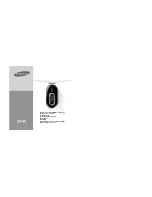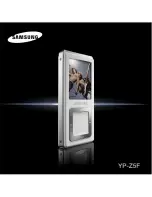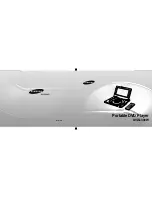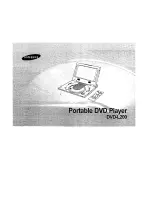
Masterpage:Right-FullCol
EN
95
Filename [HM-100U_Eng_05Index.fm]
GLOSSARY
Glossary
Digital Broadcasts and D-VHS
Great changes in the entertainment and media industries
are transforming the way we use VHS, and digital
broadcasting is a good example of what the future holds.
Digital broadcasting now allows more efficient use of the
limited broadcast spectrum besides delivering high-
definition video, outstanding sound quality, multiple
channels, and multiple features.
Meanwhile, VHS has evolved with the advances in
broadcasting in response to the need for continued use of
existing VHS resources and the trend toward digital
broadcasts.
Digital broadcasting is not limited to transmissions of
audio and video content. A variety of other data can be
sent as well. As the means to record all of these digital
signals while supporting playback of the extensive VHS
library of analog tapes, D-VHS was developed.
This VCR is equipped with an MPEG-2 encoder and
decoder (codec) for digital recording and playback of
analog signals.
D-VHS is the key to a smooth transition from analog to
digital formats. This next-generation home video
technology lets us continue to enjoy home video
entertainment as popularized in the last century well into
the next.
Dolby Digital
A form of digital audio coding developed by Dolby
Laboratories to deliver surround sound with 5.1 channels
(front left and right, center, rear left and right, and a
channel for LFE (low-frequency effects).
When you play back a digital tape encoded in Dolby
Digital format, the Dolby Digital bitstream is sent from
the DIGITAL OUT OPTICAL connector.
Set “OPTICAL OUT” to “Dolby D” (
DTS
Abbreviation for Digital Theater Systems. A digital
surround sound system for theaters, developed by Digital
Theater Systems, Inc, of the United States. The encoding
format, similar to Dolby Digital, is configured with six
(5.1) channels. The sound data is compressed when it is
recorded on the medium (CD-ROM), however since the
level of compression is low, superior clarity and depth in
sound is achieved.
As this VCR is not equipped with a DTS decoder, connect
the [OPTICAL] terminal to an AV amplifier with built-in
DTS and set “OPTICAL OUT” to “STREAM” (
to output digital surround sound.
DTS, DTS Digital Out are trademarks of Digital Theater Systems,
Inc.
HDCP
Abbreviation for High-bandwidth Digital Content
Protection. HDCP is a specification originally developed
by Intel Corporation to enforce copyrights of digital
entertainment content across the DVI interface, and now
across the HDMI interface as well.
HDMI
Abbreviation for High-definition Digital Multimedia
Interface. HDMI which was built on the foundation of
DVI-HDCP, transmits uncompressed high definition
video and multichannel digital audio in a single cable
with a maximum data transfer speed of 5Gbits/sec. HDMI
eliminates the maze of cables behind entertainment
systems while maintaining backward compatibility with
DVI-HDCP devices.
HDMI supports uncompressed standard, enhanced and
high definition video format as well as compressed audio
formats such as Dolby Digital, DTS and uncompressed
format such as PCM etc. In addition, it also supports the
HDCP standard of digital video signals.
HDMI, the HDMI logo and High-Definition Multimedia
Interface are trademarks or registered trademarks of HDMI
Licensing LLC.
i.LINK
i.LINK is a digital serial interface that allows devices
equipped with an i.LINK connector to exchange digital
video signals, digital audio signals, and device control
signals bi-directionally over a single cable.
i.Link refers to the IEEE1394-1995 industry specification and
extensions thereof. The
A
logo is used for products compliant
with the i.Link standard.
Linear PCM Audio
Conventional D-VHS recording uses MPEG-1 Layer 2
compression to record analog audio digitally.
For recording without compression, this VCR also
features PCM recording (pulse code modulation: 48 kHz,
16-bit, 1536 kbps).
Used with high-resolution HS/STD mode, it offers
outstanding high-fidelity recording and playback.
(Recording from audio input alone is not supported.)
MPEG2
Abbreviation for Moving Picture Experts Group, Phase 2.
Unlike previous compression methods, MPEG-2 uses an
extremely efficient compression method that supports
high-definition video. Based on the principle that much
video data remains unchanged from one frame to the
next, predictive coding is performed to eliminate
redundant data.
Specifically, compression is applied between frames
(based on the correlation of frame data) and within
frames (based on DCT, or discrete cosine transform) for
an extremely efficient compression technique.
Manufactured under license from Dolby Laboratories.
Dolby, Pro Logic, and the double-D symbol are
trademarks of Dolby Laboratories. Confidential
unpublished works. Copyright 1992-1997 Dolby
Laboratories. All rights reserved.
HM-DH100U_Eng.book Page 95 Thursday, August 5, 2004 1:54 PM






































